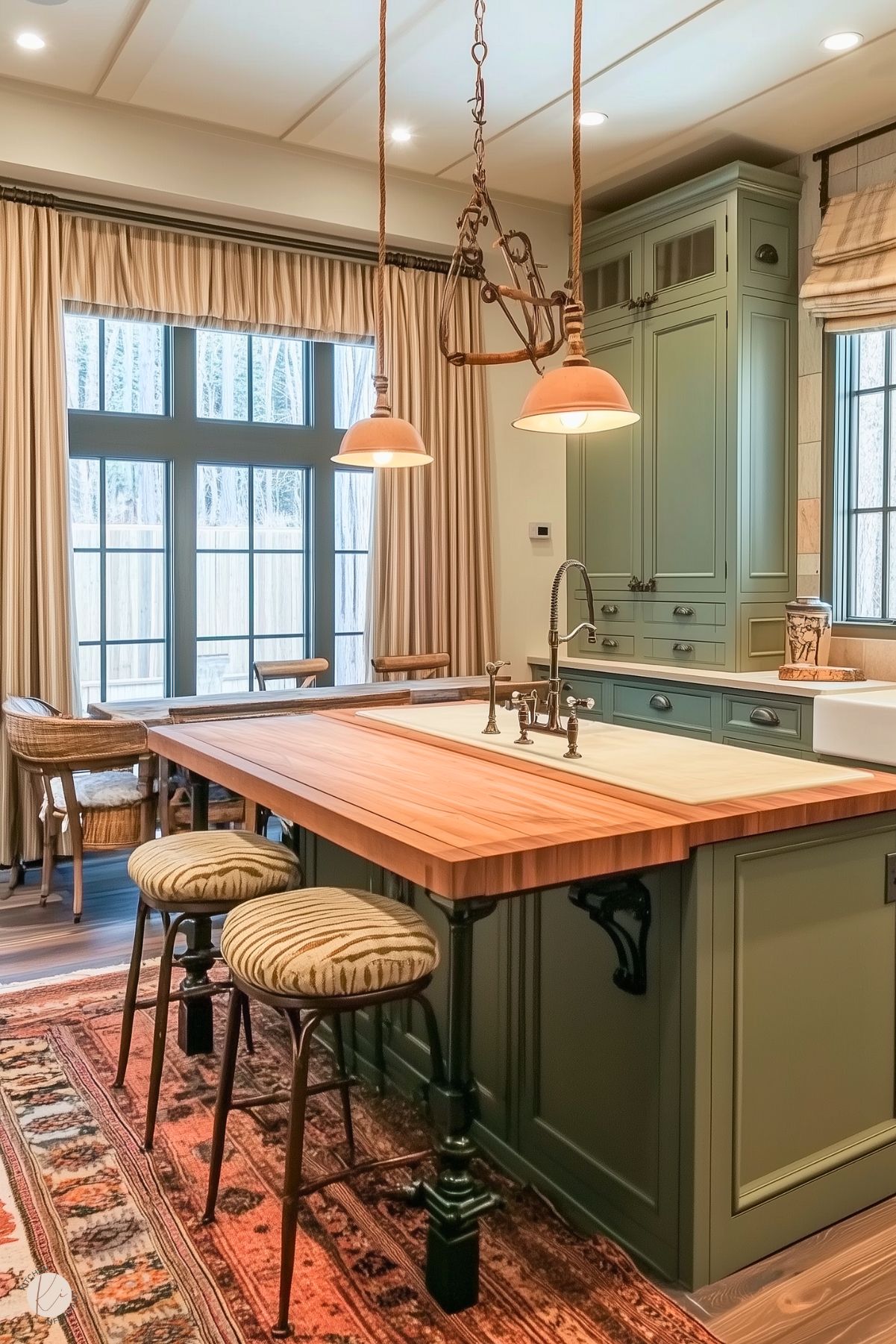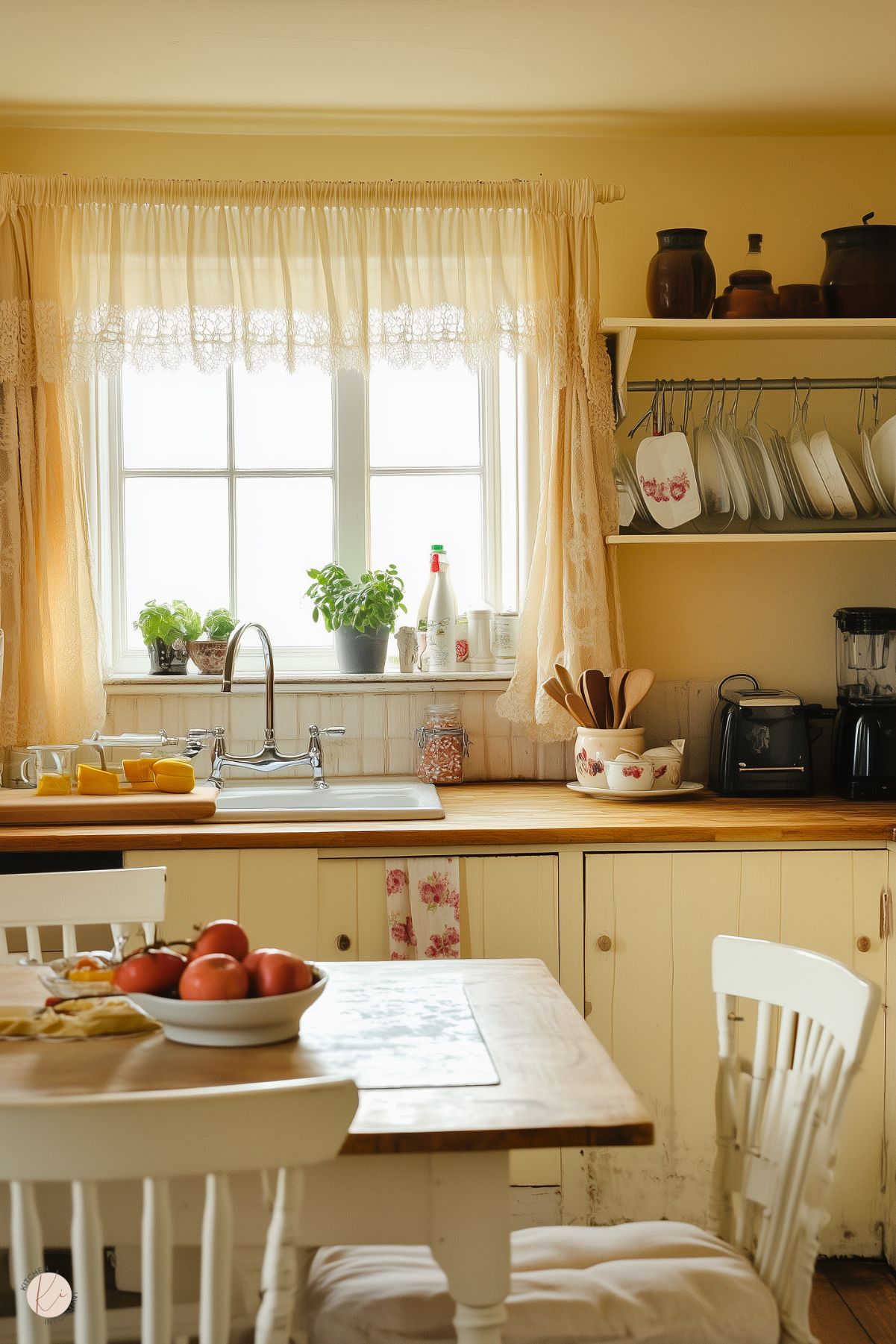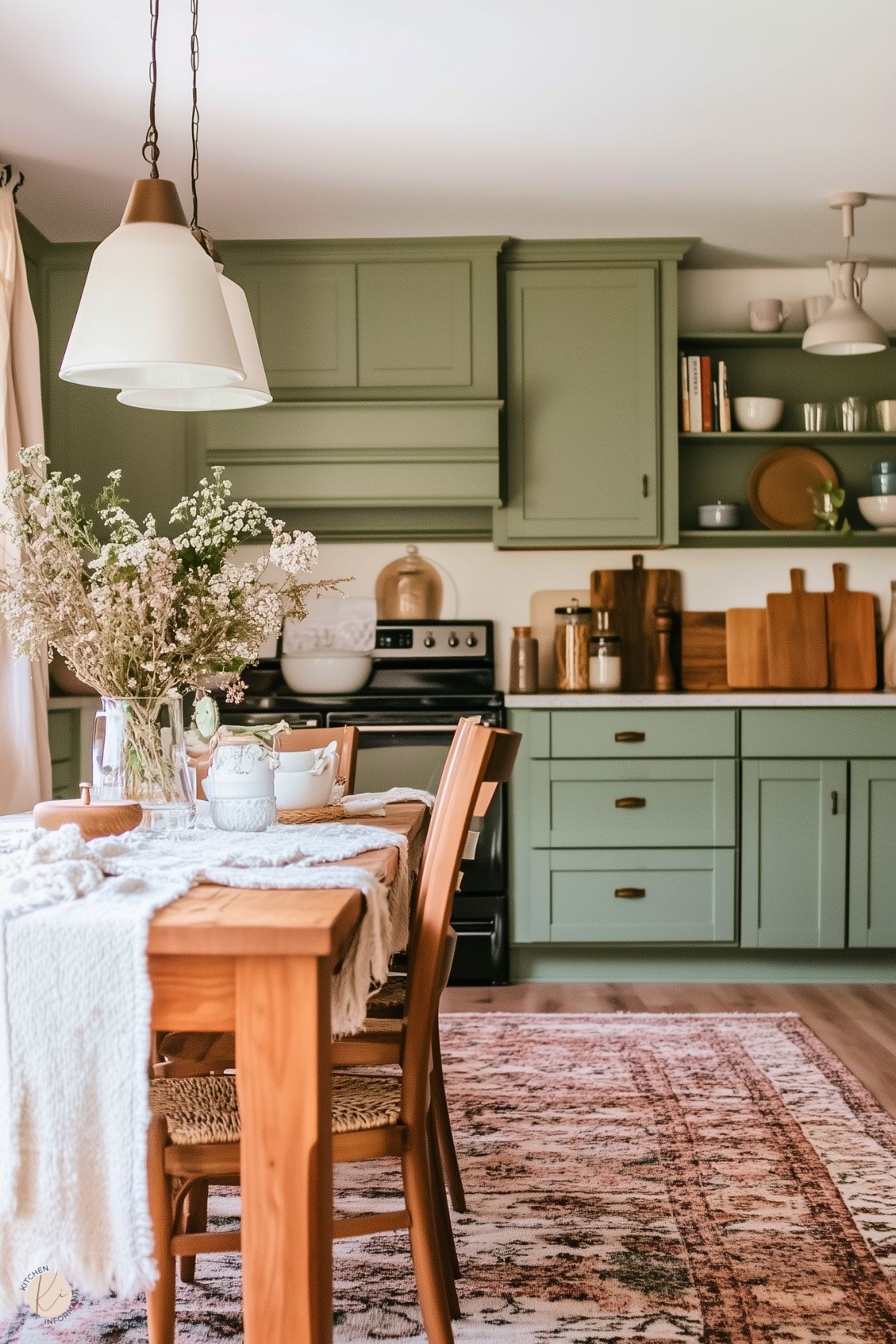A cozy kitchen can be the heart of the home, inviting family and friends to gather for meals and laughter.
Creating a warm and inviting atmosphere is easier than one might think, with simple changes that make a big difference.
From incorporating warm wood tones to adding personal touches like artwork or family photos, there are many ways to transform a kitchen into a comfortable space.

The choice of materials plays a significant role in the kitchen’s vibe.
Natural materials like wood and soft fabrics can enhance the cozy feel, making the space more welcoming.
Simple additions, such as a kitchen rug or an inviting chair, can encourage people to spend more time there, turning cooking and dining into cherished moments.

The Heart of Home: Understanding Kitchen Coziness
A cozy kitchen feels warm and inviting, making it a space where family and friends gather. Key elements include a welcoming atmosphere and personal touches that create a homey vibe.
Defining a Cozy Kitchen
A cozy kitchen often combines comfort and style. It is a place where colors, textures, and lighting work together to create warmth.
- Color: Soft, warm colors like creams and muted pastels can enhance coziness. Bold accents add personality without overwhelming the space.
- Materials: Natural materials like wood and stone contribute to a warm feel. Soft textiles, such as cushioned seating or table linens, can add comfort.
- Lighting: Soft, ambient lighting from lamps or dimmable fixtures creates a relaxing environment. Mixing light sources helps to soften the room.
Importance of a Welcoming Atmosphere
A welcoming atmosphere in the kitchen fosters connection and joy. It encourages people to spend time together, whether cooking or simply enjoying a meal.
- Personal Touches: Personal items, like photos or handmade decor, make the kitchen feel special. This reflects the owner’s personality and adds charm.
- Functional Space: A clutter-free kitchen makes it easy to move around. Organizing tools and ingredients enhances usability and keeps stress levels low.
- Comfortable Seating: Incorporating areas for sitting invites people to linger. Whether it’s a breakfast nook or bar seating, comfort is key.
Color Palette Choices

Choosing the right colors for a kitchen can create a warm and inviting atmosphere. Different color palettes can evoke feelings of comfort and style, making the kitchen an appealing space for everyone.
Warm Colors and Their Effects
Warm colors, such as reds, yellows, and oranges, can infuse a kitchen with energy and comfort. These hues are known to create a cozy and inviting environment.
She can use warm colors to encourage social interaction, making it a great spot for family gatherings.
These colors can also make a space feel more intimate. For instance, a terracotta backsplash can bring a homey charm, while soft butter yellow walls can brighten the area without being too overwhelming.
Using warm colors in the kitchen can also play into the trends of cozy home design. By focusing on warmth, it enhances the inviting nature of the kitchen, perfect for meal preparation and gatherings.
Choosing the Right Shades and Tones
Selecting the right shades is essential for achieving a cohesive look.
It’s important to balance brighter colors with softer shades. For example, pairing a bright red with beige or soft cream can create visual interest without overwhelming the space.
Neutral tones should serve as a foundation for larger elements like cabinets and countertops. This way, stylish, bold colors can be added through accessories like dishware or kitchen towels.
She can also consider the size of the kitchen when picking colors. Light, airy shades can help a small kitchen feel more spacious, while deeper colors can create a more intimate vibe in larger areas.
Lighting and Ambiance

Creating a cozy kitchen is largely about how light interacts with the space. Good lighting can enhance warmth and make tasks easier.
Different lighting techniques and natural light options can transform the kitchen into a welcoming spot for family and friends.
Natural Light Maximization
Maximizing natural light can change the feel of a kitchen dramatically.
Large windows allow sunlight to pour in, giving the space a bright and airy vibe. Using sheer curtains can help diffuse this light while maintaining privacy.
Adding mirrors can also reflect natural light, making the space feel larger and brighter. Placing plants near windows invites nature inside and brings life to the area.
Skylights are another fantastic option. They let in even more sunlight, creating a cheerful atmosphere during the day.
Layered Lighting Techniques
Layered lighting is key for creating a cozy kitchen ambiance.
This involves using multiple types of light sources for different tasks and moods.
For example, pendant lights over an island offer focused task lighting.
Under-cabinet lights can add warmth and highlight countertops, while recessed lights provide overall illumination.
Dimmers can control the brightness level, allowing for a softer light when entertaining.
Mixing different light sources creates visual interest and enhances the kitchen’s cozy atmosphere.
Adding Softness with Accent Lights
Accent lighting introduces warmth and softness to the kitchen.
Sconces can be placed above task areas, adding gentle light without being harsh. They also serve as decorative elements.
String lights can be a charming addition. These can wrap around shelves or windows for a casual, inviting feel.
Soft-glow light bulbs create a warm color temperature, further enhancing the cozy vibe.
Using a variety of accent lights at different heights adds depth, making the kitchen feel welcoming and friendly.
Furniture and Layout

Creating a cozy kitchen involves thoughtful furniture choices and an effective layout.
By prioritizing comfort and functionality, anyone can transform their kitchen into a welcoming space for family and friends.
Comfortable Seating Arrangements
Seating can greatly influence how cozy a kitchen feels.
A round table can create an inviting atmosphere for meals and conversations. It allows for easy movement and encourages interaction.
Adding soft, upholstered chairs or benches can also enhance comfort.
Key Points for Seating:
- Use a mix of freestanding and built-in furniture.
- Consider adding cushions for extra comfort.
- Choose warm, inviting colors for fabrics.
Another option is to incorporate a breakfast nook. This space provides a casual spot for quick meals while making the kitchen feel more homey.
Functional Space Planning
Effective space planning is crucial for creating a cozy kitchen.
It’s important to ensure that the layout promotes ease of movement while also fostering warmth.
Tips for Space Planning:
- Keep frequently used items within easy reach.
- Leave enough room between counters and appliances for a smooth workflow.
- Implement open shelving to display pretty dishes or plants.
Adding elements like a kitchen island can create a central gathering spot while providing extra storage. This approach encourages cooking and socializing at the same time.
Careful attention to layout can truly enhance the comfort level in a kitchen.
Textiles and Soft Furnishings

Textiles and soft furnishings are essential for creating a warm and inviting kitchen atmosphere.
By adding comfortable elements, the space can transform into a cozy retreat that invites relaxation and connection.
Cushions and Rugs
Cushions and rugs can significantly enhance the comfort level in a kitchen.
Cushions are great for seating and can comfort hard stools or benches. Choosing cushions in warm colors or soft fabrics can create a welcoming vibe.
Rugs also add warmth to the room.
Placing a plush rug under a dining table or in front of the sink can soften the hard surfaces of a kitchen. Look for rugs that are machine washable for easy maintenance. Textures and patterns can also help break the monotony of a kitchen’s hard finishes.
Window Treatments
Window treatments are another key element in making a kitchen feel cozy.
Simple curtains or fabric shades can soften the look of the space. Opt for light, airy fabrics that allow natural light to filter through while providing some privacy.
Sink curtains are a trendy choice, offering a homey touch. They can hide dish racks or cleaning supplies, making the space appear tidier.
Sheer fabrics can create a calm, inviting atmosphere, while bold patterns can add personality. Incorporating these elements fosters a more lived-in feel and encourages warmth.
Personal Touches

Adding personal touches to a kitchen can create a warm and inviting atmosphere. Family photos and unique items help people connect with their kitchen space, making it feel more like home.
Family Photos and Artwork
Incorporating family photos in the kitchen can bring joy and nostalgia. Displaying pictures of loved ones, special occasions, or favorite memories can create a cozy vibe.
Tips for Displaying Photos:
- Gallery Wall: Create a small gallery wall with frames in different styles for a playful touch.
- Magnetic Frames: Use magnetic photo frames on the refrigerator for easy swapping and updates.
- Artistic Touches: Consider using artwork that reflects family interests, such as cooking or nature.
These personal elements not only beautify the space but also remind everyone of shared experiences while enjoying meals together.
Display of Heirlooms and Trinkets
Showing off family heirlooms or special trinkets can tell stories and make the kitchen feel more welcoming. These items can range from vintage dishware to handmade pottery.
How to Showcase Heirlooms:
- Open Shelves: Use open shelving to display favorite dishes or collectibles while keeping them accessible.
- Decorative Jars: Fill jars with spices, flour, or even colorful beans for both beauty and practicality.
- Spotlight Favorites: Choose a few key pieces to highlight, such as a grandparent’s rolling pin or a unique coffee mug collection.
These displays not only enhance the kitchen decor but also spark conversation and connection among family and friends.
Scents and Aromatherapy

Adding scents to the kitchen can create a warm and inviting atmosphere. Aromatherapy products, such as candles and diffusers, help establish a cozy ambiance.
Natural kitchen aromas can also enhance the cooking experience. Both options bring comfort and charm to the space.
Candles and Diffusers
Candles are a popular choice for creating a cozy atmosphere. Scented candles, like vanilla or cinnamon, fill the kitchen with delightful aromas. They can be lit while cooking or during relaxed moments.
Diffusers are another great option. They disperse essential oils into the air. Users can choose refreshing scents like lemon or calming aromas like lavender. This makes the kitchen feel welcoming.
It’s best to select high-quality candles and oils. Look for products made with natural ingredients. This ensures a clean burn and better scents without harsh chemicals.
Natural Kitchen Aromas
Natural aromas can come directly from the kitchen during cooking. Ingredients like garlic, onions, or herbs can fill the air with comforting smells. Simmering spices, such as cinnamon or cloves, can also create a warm, inviting scent.
Another simple idea is to place fresh fruits and herbs around the kitchen. Lemons, oranges, or fresh basil not only look nice but also add pleasant fragrances.
In addition, making stovetop potpourri is an easy way to enjoy lovely scents. Combining water with fruits, herbs, and spices can create inviting aromas while cooking or cleaning.
It’s a delightful way to make the kitchen feel warm and cozy.
Plants and Greenery

Adding plants to a kitchen can create a warm and inviting atmosphere. Here are two great ways to enhance the coziness in this space through greenery.
Indoor Herb Garden
An indoor herb garden is a practical and charming option for any kitchen. Basil, mint, and rosemary are popular choices that thrive indoors. Placing these herbs on a windowsill ensures they receive enough sunlight.
To start, select pots that complement the kitchen decor. Use small containers for individual herbs or a larger one for multiple plants. Regular watering is essential, but it’s important not to overwater.
Herbs can also be used in cooking, adding fresh flavors to meals. Plus, having them nearby makes cooking more enjoyable. It connects cooking with gardening, offering a delightful space to spend time.
Low-Maintenance Houseplants
For those who may not have a green thumb, low-maintenance houseplants are a fantastic choice. Succulents and snake plants are ideal for busy lifestyles. They require minimal care and can thrive in various light conditions.
Succulents come in many shapes and colors, making them fun decor elements. Snake plants, known for their air-purifying qualities, can be placed in corners or on countertops.
These plants add life to the kitchen without needing constant attention. Just occasional watering is enough for these hardy varieties. This way, a cozy kitchen can be maintained effortlessly.
Storage and Clutter Management

Effective storage and clutter management can transform a kitchen into a more inviting space. By implementing organizational systems and minimizing visual clutter, anyone can create a cozy atmosphere that feels both practical and welcoming.
Organizational Systems
Creating a useful organizational system is key to managing kitchen clutter. Start by grouping similar items together. Use labeled bins or baskets to store utensils, gadgets, and other cooking tools. This makes it easier to find what’s needed.
Vertical space can be maximized by installing shelves or pegboards. A pegboard can hold pots, pans, and measuring cups, keeping them accessible without taking up counter space. Additionally, drawer organizers can separate items like cutlery and cooking tools, ensuring they stay neat.
Incorporating a countertop crock to hold utensils can keep them close at hand. A wall-mounted rack for pots and pans can free up valuable cabinet space. These systems not only enhance functionality but also add style to the kitchen.
Minimizing Visual Clutter
Minimizing visual clutter plays a crucial role in making a kitchen feel cozy. Start by clearing off countertops. Leave only essential items, like a coffee maker or a stylish fruit bowl, to help maintain an open and airy look.
Using decorative storage solutions can be helpful. Attractive jars can hold frequently used ingredients, while stylish canisters can store dry goods. This combines functionality with aesthetics, making the kitchen visually appealing.
Consider using cabinetry to hide smaller appliances that are not used daily. This keeps surfaces clear and contributes to a tidy environment.
Adding plants can also soften the hard edges in the kitchen, breaking up clutter while adding a homey touch.
Seasonal and Holiday Decor

Seasonal and holiday decor can transform a kitchen into a warm and inviting space. Simple changes can bring new life to the room while celebrating the spirit of each season.
Changing Themes with Seasons
Switching decor with the seasons can refresh the kitchen’s atmosphere. For spring, adding pastel colors through tablecloths or dish towels creates a light and airy feel. Summer can shine with bright fruits displayed in bowls, enhancing both decor and function.
Autumn brings a cozy vibe with warm tones; consider using deep reds, oranges, and browns. Decorating with pumpkins or leaves can amplify this seasonal charm. Winter often invites festive decor, so adding garlands or twinkling lights makes the kitchen feel magical.
Using a few simple pieces can set the tone and welcome each season effectively.
Festive Touches
Incorporating festive touches can quickly upgrade holiday spirit. During Christmas, decorative wreaths hung on cabinet doors add charm. The use of red and green dishware also enhances the festive atmosphere.
For Thanksgiving, a centerpiece made of seasonal fruits—like pomegranates and cranberries—brings color and warmth to the table. Using scented candles with holiday fragrances can further liven up the space.
Changing drawer knobs to holiday-themed options, such as snowflakes or candy canes, can be a fun twist.
Displaying homemade treats in jars allows for both decoration and deliciousness. Embracing these touches creates a cozy and cheerful kitchen that celebrates the joy of the season.
Music and Sound

Creating a cozy kitchen atmosphere can be enhanced with the right music and sound choices.
Thoughtful selection of background music and sound-absorbing materials can transform the kitchen into a warm and inviting space.
Background Music Options
Incorporating background music can significantly uplift the mood in a kitchen. Soft instrumental music, such as jazz or acoustic guitar, can create a calming ambiance while cooking or dining.
Playlists featuring nature sounds, like gentle rain or ocean waves, can also add a serene touch. Streaming services often have ready-made playlists, making it easy to set the right vibe.
When hosting gatherings, consider creating an upbeat playlist with favorite songs. This encourages conversation and enhances the overall dining experience.
Tip: A portable speaker can help spread sound evenly throughout the kitchen, allowing everyone to enjoy the music regardless of where they are.
Sound Absorbing Materials
Sound-absorbing materials can help reduce noise and create a peaceful environment. Adding textiles like plush seat cushions or table runners can help absorb sound.
Using fabrics in warm colors not only enhances comfort but also contributes to the room’s coziness. Wall art or decorative fabric hangings can also serve practical sound-absorbing purposes.
List of Effective Sound-Absorbing Materials:
- Rugs: They soften footsteps and reduce echoes.
- Cushions: Use on chairs and benches for added comfort.
- Curtains: Thick curtains can dampen external noise while adding warmth to the space.
Technology Integration

Integrating technology in the kitchen can enhance the cooking experience while making it more inviting.
Smart appliances and convenient gadgets offer ease of use and efficiency, helping to create a cozy atmosphere.
Smart Appliances
Smart appliances have made significant strides in the kitchen. These devices connect to the internet and can be controlled remotely.
For example, a smart refrigerator can track food inventory, suggest recipes, and even create shopping lists.
Other appliances, like smart ovens, allow users to monitor cooking progress from their smartphones. Some models can even be preheated from a distance.
These features not only save time but also reduce stress, making meal preparation more enjoyable. With smart appliances, the kitchen feels more like a comforting hub of activity.
Convenient Gadgets
Convenient gadgets can transform everyday tasks into seamless experiences. Items like smart coffee makers can brew coffee at a scheduled time or via an app, ensuring a fresh cup is ready when needed.
Programmable slow cookers also fit the bill. They allow for hands-free cooking, letting users prepare meals in advance. These devices can be controlled remotely, which adds convenience and flexibility.
Small gadgets like electric kettles and food processors can speed up cooking tasks. With these tools, the kitchen becomes not just functional, but a cozy place for delicious meals and memories.
Healthy Kitchen Practices

Creating a cozy kitchen is not just about decor; it’s also about fostering healthy practices. These habits can make the kitchen a more inviting and functional space.
Focusing on ergonomic design and maintaining cleanliness plays a significant role in improving comfort and efficiency.
Ergonomic Design
A well-designed kitchen promotes comfort and reduces strain. Ergonomics involves arranging your cooking space to fit the user’s needs.
This can include adjusting counter heights and ensuring that frequently used items are within easy reach.
Key tips for ergonomic kitchen design include:
- Counter Height: Standard counters are usually 36 inches high. Adjust them as needed for regular use.
- Storage Solutions: Use pull-out shelves or lazy Susans to access items easily.
- Placement of Appliances: Position frequently used appliances like the toaster or coffee maker close to work areas.
Maintaining Cleanliness
A clean kitchen enhances both the cooking experience and overall health.
Regular cleaning prevents the buildup of bacteria and keeps the space inviting. Adopting a cleaning routine can help make this task manageable.
Effective cleaning practices include:
- Daily Tasks: Wipe down counters, wash dishes, and sweep the floor every day.
- Weekly Deep Clean: Focus on larger tasks like mopping floors, cleaning appliances, and disinfecting surfaces.
- Organized Storage: Keep cleaning supplies accessible for quick use. Consider using a caddy to store essential items.
Staying organized and maintaining cleanliness creates a healthier and cozier kitchen environment.
This makes the kitchen not just a place to cook, but a space where family and friends can gather comfortably.







You May Also Like:






